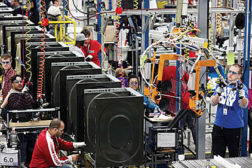Home » manufacturing jobs
Articles Tagged with ''manufacturing jobs''
Ready, Set, Go!
Assemblers are busier than ever, thanks to the U.S. manufacturing revival.
July 1, 2013
Never miss the latest news and trends driving the manufacturing industry
Stay in the know on the latest assembly trends.
JOIN TODAY!Copyright ©2024. All Rights Reserved BNP Media.
Design, CMS, Hosting & Web Development :: ePublishing










